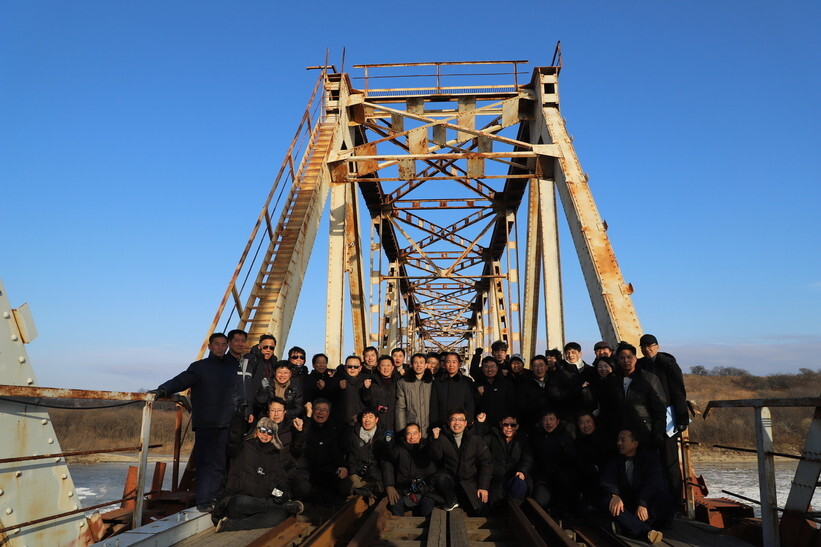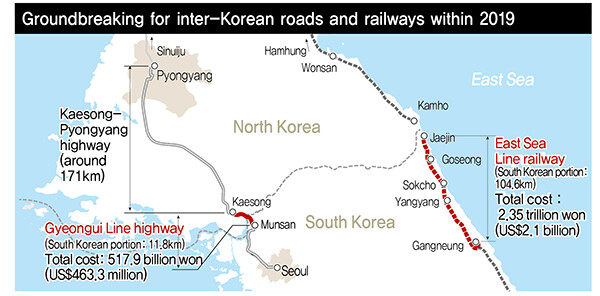hankyoreh
Links to other country sites 다른 나라 사이트 링크
S. Korea to resume inter-Korean railroad project with N. Korea

The South Korean government is resuming efforts to move forward with a cooperative project with North Korea to connect their railroad systems. The first step will be connecting a break in the South Korean section of the Donghae Line, which runs along Korea’s eastern coast. Officials hope that this will kickstart efforts to reconnect the two sides’ railroad systems and realize the vision of the “East Asian Railroad Community.”
South Korea’s Unification Ministry and Ministry of Land, Infrastructure, and Transport announced on Apr. 20 that a ceremony celebrating efforts to complete the northern section of the Donghae Line will be held on Apr. 27 at Jejin Station in Goseong County, Gangwon Province. Apr. 27 will be the second anniversary of the Panmunjom Declaration made by South Korean President Moon Jae-in and North Korean leader Kim Jong-un.
The northern section of the Donghae Line, a 104.6km stretch that would run between Gangneung and Jejin, is effectively the only unconnected section of the Donghae Line (the eastern wing of the proposed Trans-Korean Railway). Work is already underway on the hitherto unconnected central section of the Donghae Line, covering the 166.3km between Pohang and Samcheok, a project that’s supposed to be wrapped up in 2022.
Unification Minister Kim Yeon-chul is expected to give the Gangneung-Jejin railroad construction plan a green light while presiding over a meeting of the Inter-Korean Exchange and Cooperation Promotion Council, which will be held on Apr. 23, prior to the ceremony for the northern section of the Donghae Line. The council’s approval would pave the way for waiving the preliminary feasibility study that would normally be necessary before construction can begin.

Technically speaking, building a railroad between Gangneung and Jejin on the northern section of the Donghae Line is a domestic infrastructure project. However, the project has major implications and great potential. For one thing, the leaders of South and North Korea have committed themselves to inter-Korean railroad cooperation on multiple occasions, including inter-Korean summits in 2007 and 2018. On top of that, the railroad is an essential prerequisite for realizing two of the Moon administration’s signature policies: the East Asian Railroad Community and the New Economic Map of the Korean Peninsula.
As far back as 1992, South and North Korea agreed to reconnect roads and railways in their Inter-Korean Basic Agreement, but 28 years after that agreement was adopted, the 110.9km stretch between Gangneung and Jejin remains severed. The main reason is that the project isn’t regarded as economically viable. That’s why the government’s announcement that it will be pushing forward with finishing the northern stretch of the Donghae Line can be understood as an expression of its firm commitment to implementing inter-Korean railroad cooperation.
Linking Donghae Line would open up EurasiaThe North Korean half of the Donghae Line, though aging and rickety, runs the entire length of the east coast without any interruptions. The line is also linked to the Trans-Siberian Railway at Tumangang (Tumen River) Station and to the Trans-Manchurian Railway and the Trans-China Railway at Namyang Station, providing rail access to the content of Eurasia.
On the South Korean half of the Donghae Line, the southern section, running from Busan to Pohang, is currently in operation, and there are also 60.3km of tracks running between Gangneung to Samcheok in the northern section. A construction project aimed at covering the unconnected central section from Samcheok to Pohang, a distance of 166.3km, is slated to conclude in 2022. (Part of this section, from Pohang to Yeongdeok, opened early, on Jan. 25, 2018.)
While the other axis of the inter-Korean railroad cooperation project is the Gyeongui (Seoul-Sinuiju) Line in the west, North Korea has taken a greater interest in the Donghae Line in the east.
Shortly before his death, North Korean founder Kim Il-sung predicted that North Korea could make more than US$1 billion a year by receiving materials exported from Russia and China’s Heilongjiang Province at Tumangang Station and then transporting them by rail along the east coast. (Kim made the comments in a meeting with the chairman of the Central Committee of the Belgian Labor Party on June 10, 1994.)
In April 2002, Kim’s son Kim Jong-il told Lim Dong-won, then a special envoy from South Korea, that he would like to see the port of Busan connected with the Trans-Siberian Railway via the Donghae Line. In fact, connecting the Trans-Siberian Railway with the Trans-Korean Railway is key to the success of the New Eastern Policy, the Far East development strategy formulated by Russian President Vladimir Putin.
There are several factors behind the South Korean government’s decision to push for building the Gangneung-Jejin railroad connection as its first gesture toward North Korea following the ruling party’s landslide victory in the parliamentary elections on Apr. 15.
The government’s first consideration is that railroad projects that involve actual movement between South and North Korea are not feasible given the UN and US’ harsh sanctions on the North and the protracted impasse in inter-Korean relations. By working to fill in the gaps in the South Korean section of the Donghae Line, South Korea can demonstrate its firm commitment to building the Trans-Korean Railway to the related players in Northeast Asia — namely, North Korea, China, and Russia — with the hope of creating a “chain reaction.”
Democratic Party’s election victory gives it political clout to continue projectA second factor is the government’s belief that the ruling party’s resounding victory in the elections gives it the political capital to overcome the economic objection to the railroad link. According to a report that the Ministry of Land, Infrastructure, and Transport presented to the National Assembly shortly after the Panmunjom Declaration on Apr. 27, 2018, linking Gangneung and Jejin by rail would probably cost 2.35 trillion won (US$1.91 billion).
Before construction can begin, the corresponding budget would have to be approved by the National Assembly, but the government thinks such approval shouldn’t be too hard to come by in the legislature’s next session, which will be dominated by the ruling Democratic Party. The election outcome has changed the political forecast in a way that could have major ramifications for efforts to court North Korea.
A third factor is the hope that such a construction project could provide a much-needed economic boost as the coronavirus outbreak drags on. In 2018, the Research Institute for Gangwon published a study predicting that a railroad construction project on the northern section of the Donghae Line would create 4.74 trillion won (US$3.85 billion) worth of manufacturing, 1.92 trillion won (US$1.56 billion) in added value, and 38,910 new jobs.
By Lee Je-hun, senior staff writer
Please direct comments or questions to [english@hani.co.kr]

Editorial・opinion
![[Column] Has Korea, too, crossed the Rubicon on China? [Column] Has Korea, too, crossed the Rubicon on China?](https://flexible.img.hani.co.kr/flexible/normal/500/300/imgdb/original/2024/0419/9317135153409185.jpg) [Column] Has Korea, too, crossed the Rubicon on China?
[Column] Has Korea, too, crossed the Rubicon on China?![[Correspondent’s column] In Japan’s alliance with US, echoes of its past alliances with UK [Correspondent’s column] In Japan’s alliance with US, echoes of its past alliances with UK](https://flexible.img.hani.co.kr/flexible/normal/500/300/imgdb/original/2024/0419/2317135166563519.jpg) [Correspondent’s column] In Japan’s alliance with US, echoes of its past alliances with UK
[Correspondent’s column] In Japan’s alliance with US, echoes of its past alliances with UK- [Editorial] Does Yoon think the Korean public is wrong?
- [Editorial] As it bolsters its alliance with US, Japan must be accountable for past
- [Guest essay] Amending the Constitution is Yoon’s key to leaving office in public’s good graces
- [Editorial] 10 years on, lessons of Sewol tragedy must never be forgotten
- [Column] A death blow to Korea’s prosecutor politics
- [Correspondent’s column] The US and the end of Japanese pacifism
- [Guest essay] How Korea turned its trainee doctors into monsters
- [Guest essay] As someone who helped forge Seoul-Moscow ties, their status today troubles me
Most viewed articles
- 1[Column] The clock is ticking for Korea’s first lady
- 2After 2 months of delayed, denied medical care, Koreans worry worst may be yet to come
- 3[Column] Has Korea, too, crossed the Rubicon on China?
- 4US overtakes China as Korea’s top export market, prompting trade sanction jitters
- 5[Correspondent’s column] In Japan’s alliance with US, echoes of its past alliances with UK
- 6Hong Se-hwa, voice for tolerance whose memoir of exile touched a chord, dies at 76
- 7All eyes on Xiaomi after it pulls off EV that Apple couldn’t
- 8[News analysis] After elections, prosecutorial reform will likely make legislative agenda
- 9More South Koreans, particularly the young, are leaving their religions
- 10John Linton, descendant of US missionaries and naturalized Korean citizen, to lead PPP’s reform effo